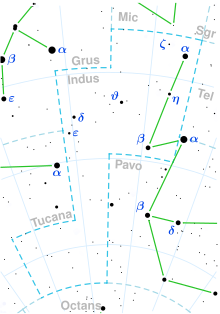HIP 107773
| Observation data Epoch J2000 Equinox J2000 | |
|---|---|
| Constellation | Indus[note 1] |
| Right ascension | 21h 50m 0.12s[1] |
| Declination | −64° 42′ 45.1″[1] |
| Apparent magnitude (V) | 5.6[1] |
| Characteristics | |
| Evolutionary stage | Horizontal branch[2][3] |
| Spectral type | K0III[1] |
| B−V color index | 0.99[4] |
| Astrometry | |
| Radial velocity (Rv) | −0.1701±0.1237[5] km/s |
| Proper motion (μ) | RA: −0.7032±0.0807 mas/yr[5] Dec.: −37.4432±0.0893 mas/yr[5] |
| Parallax (π) | 9.5919 mas[1] |
| Distance | 343.9±2.6 ly (105.5±0.8 pc)[2] |
| Absolute magnitude (MV) | 0.54[4] |
| Details[3] | |
| Mass | 2.42±0.27 M☉ |
| Radius | 11.6±1.4 R☉ |
| Luminosity | 74.13+1.12 −1.15 L☉ |
| Surface gravity (log g) | 2.6±0.2 cgs |
| Temperature | 4945±100 K |
| Age | >1[2] Gyr |
| Other designations | |
| Database references | |
| SIMBAD | data |
HIP 107773 is a star located 344 light years from Earth in the southern constellation Indus.[2][note 1] It is classified as a horizontal branch K-type giant star,[2][3] having a spectral type K0III[1] and a radius of 11.6 R☉.[5] With an apparent magnitude of 5.6, the star can be faintly seen with the naked eye.[1] It has an exoplanet, HIP 107773 b, a gas giant orbiting it at a distance of 0.72 astronomical units (108,000,000 km),[6] about the same distance from Venus to the Sun.[a]
Characteristics
[edit]HIP 107773 is a giant star, having a spectral type K0III,[1] where K0 means it is a K-type star and III (luminosity class) means it is a giant star. The star is in the horizontal branch phase of evolution.[3][2] HIP 107773 has a radius equivalent to 11.6 solar radii, and a mass equivalent to about 2.4 solar masses.[3] It is cooler than the Sun, having an effective temperature of 4,945 K (4,672 °C).[3][b] Given the mass and the evolutionary stage of the star, its age is estimated to be at least about one billion years.[2]
Planetary system
[edit]HIP 107773 has an exoplanet, HIP 107773 b, discovered in 2015 using the radial velocity method.[6][3] The planet is classified as a gas giant, having a minimum mass of 2 MJ[3] and an estimated radius of 1.19 RJ.[6] It orbits its star at a distance of 0.72 astronomical units (108,000,000 km), about the same distance as Venus is from the Sun,[a] and completes one orbit every 144 days (0.39 years).[3] Its orbit is almost circular, with an eccentricity of just 0.09.[3]
With a mass of 2.4 M☉, the star HIP 107773 is one of the most massive stars with a close-in planet.[3][9]
| Companion (in order from star) |
Mass | Semimajor axis (AU) |
Orbital period (days) |
Eccentricity | Inclination | Radius |
|---|---|---|---|---|---|---|
| b | ≥1.98±0.21 MJ | 0.72±0.03 | 144.3±0.5 | 0.09±0.06 | — | 1.19 (estimate)[6] RJ |
See also
[edit]Notes and references
[edit]- ^ a b c d e f g h i j "HIP 107773". SIMBAD. Retrieved January 21, 2024.
- ^ a b c d e f g Ginski, C.; Mugrauer, M.; Adam, C.; Vogt, N.; Holstein, R. G. van (2021-05-01). "How many suns are in the sky? A SPHERE multiplicity survey of exoplanet host stars - I. Four new close stellar companions including a white dwarf". Astronomy & Astrophysics. 649: A156. arXiv:2009.10363. doi:10.1051/0004-6361/202038964. ISSN 0004-6361.
- ^ a b c d e f g h i j k l Jones, M. I.; Jenkins, J. S.; Rojo, P.; Olivares, F.; Melo, C. H. F. (2015-08-01). "Giant planets around two intermediate-mass evolved stars and confirmation of the planetary nature of HIP 67851c". Astronomy & Astrophysics. 580: A14. arXiv:1505.06718. doi:10.1051/0004-6361/201525853. ISSN 0004-6361.
- ^ a b "HIP-107773 (Star)". In-The-Sky.org. Retrieved January 21, 2024.
- ^ a b c "HIP 107773 Overview". NASA Exoplanet Archive. Retrieved January 21, 2024.
- ^ a b c d "HIP 107773b". Exoplanet Exploration: Planets Beyound Our Solar System. Retrieved January 21, 2024.
- ^ "Venus Fact Sheet". nssdc.gsfc.nasa.gov. Retrieved January 21, 2024.
- ^ "Sun Fact Sheet". nssdc.gsfc.nasa.gov. Retrieved January 21, 2024.
- ^ "HIP 107773 b". Open Exoplanet Catalogue. Retrieved January 21, 2024.

